By Leen Randell
Updated: Jul 04, 2024
10 Best Herbal Decoctions For Leg Pain
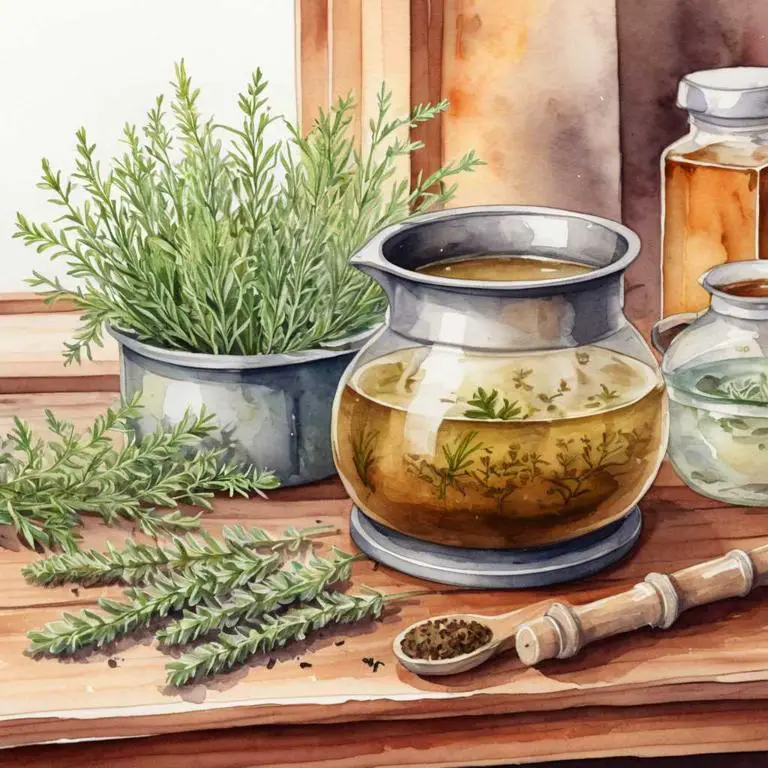
Herbal decoctions for leg pain are a natural and effective way to alleviate discomfort and stiffness in the legs.
These decoctions, made by steeping herbs in hot water, work by reducing inflammation and promoting blood flow to the affected area. Turmeric, ginger, and cayenne pepper are examples of herbs that have anti-inflammatory properties and can be combined to create a soothing leg pain relief decoction.
By using these herbal decoctions, individuals with chronic leg pain can experience significant improvement in their quality of life, allowing them to engage in daily activities without discomfort and enjoy better overall well-being.
The following article describes in detail the most important decoctions for leg pain, including medicinal properties, parts of herbs to use, and recipes for preparations.
- 1. Salix alba
- 2. Capsicum annuum
- 3. Boswellia serrata
- 4. Glycyrrhiza glabra
- 5. Curcuma longa
- 6. Camellia sinensis
- 7. Piper nigrum
- 8. Arnica montana
- 9. Echinacea purpurea
- 10. Calendula officinalis
- What is the best combination of herbal decoctions to use for leg pain?
- What ailments similar to leg pain are treated with herbal decoctions?
1. Salix alba
White willow decoctions helps with leg pain because they contain salicin, a natural analgesic and anti-inflammatory compound that targets the root cause of discomfort.
The decoction's active ingredients work to reduce swelling and ease muscle tension in the legs, providing relief from stiffness and soreness.
Additionally, white willow's gentle, soothing properties help to calm inflammation and promote relaxation, allowing for improved mobility and reduced pain perception.
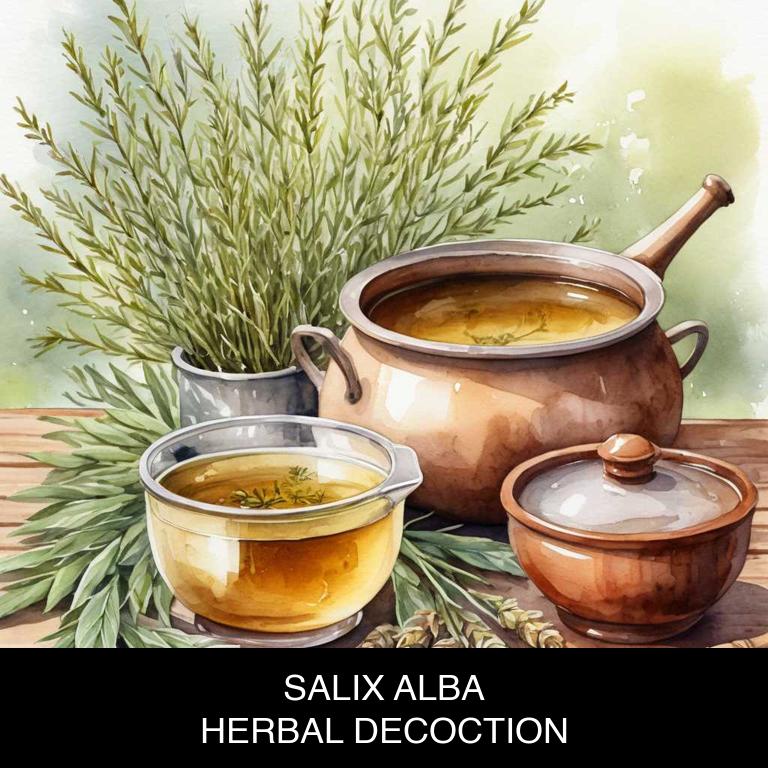
Medicinal Constituents
The list below shows the primary medicinal constituents in Salix alba decoctions that help with leg pain.
- Salicin: Salicin, a phenolic compound, helps with leg pain by acting as a natural anti-inflammatory and analgesic, reducing pain and inflammation in the affected area.
- Salicylic acid: Salicylic acid, a phenolic acid, helps with leg pain by inhibiting the production of pain-causing chemicals in the body, such as prostaglandins, and reducing inflammation.
- Flavonoids: Flavonoids, a class of plant compounds, help with leg pain by acting as antioxidants and anti-inflammatory agents, reducing oxidative stress and inflammation in the body.
Parts Used
The list below shows the primary parts of white willow used to make decoctions for leg pain.
- Barks: The barks are commonly used due to their anti-inflammatory properties, which help alleviate pain and swelling associated with leg pain.
- Stems: The stems are used for their analgesic and anti-inflammatory properties, which help reduce pain and inflammation in the legs.
- Leaves: The leaves are used for their anti-inflammatory and analgesic properties, which help reduce pain and inflammation in the legs, making them a popular choice for leg pain decoctions.
Quick Recipe
The following recipe gives a procedure to make a basic white willow for leg pain.
- Gather 1-2 pounds of dried salix alba bark and store it in an airtight container for future use.
- Combine 1 teaspoon of dried salix alba bark with 8 ounces of water in a saucepan.
- Bring the mixture to a boil over medium heat then reduce the heat to low.
- Simmer the decoction for 10-15 minutes or until the liquid has reduced slightly to 6 ounces.
- Strain the decoction through a cheesecloth or a fine-mesh sieve into a clean glass container.
2. Capsicum annuum
Bell pepper decoctions helps with leg pain because it contains a rich source of anti-inflammatory compounds, such as capsaicin and carotenoids.
These bioactive molecules work to reduce inflammation in the affected area, which can help alleviate discomfort and numbness caused by conditions like sciatica or peripheral artery disease.
The decoction's warmth also promotes blood circulation, relaxing tense muscles and reducing stiffness in the legs, leading to significant relief from pain and discomfort.
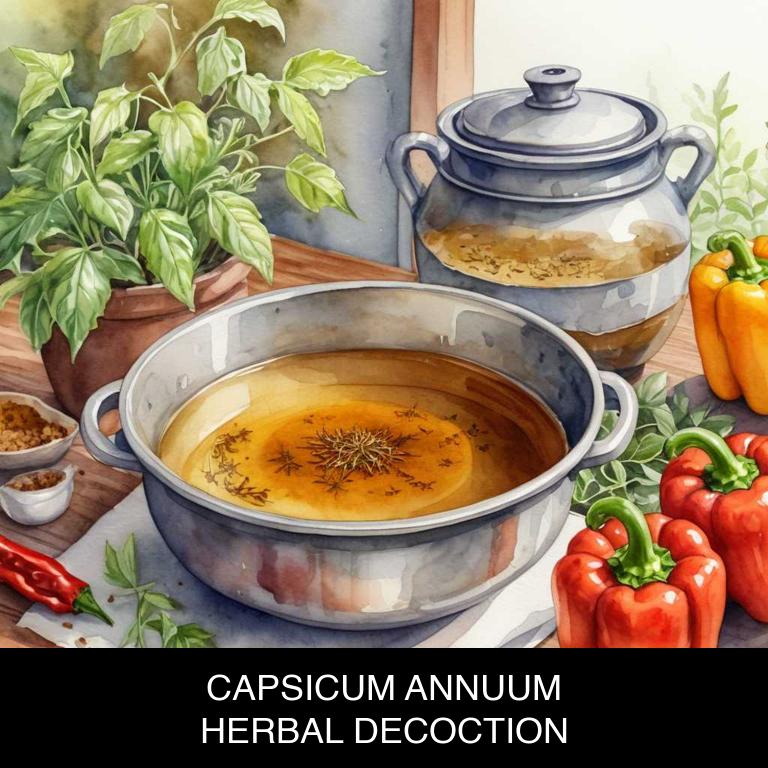
Medicinal Constituents
The list below shows the primary medicinal constituents in Capsicum annuum decoctions that help with leg pain.
- Capsaicin: Capsaicin, a phenolic compound, helps alleviate leg pain by blocking the production of a chemical called substance P, which transmits pain signals to the brain.
- Flavonoids: Flavonoids, a class of plant-based phenolic compounds, help reduce inflammation and relieve pain by inhibiting the production of pro-inflammatory enzymes and cytokines.
- Carotenoids: Carotenoids, such as capsanthin and capsorubin, help reduce oxidative stress and inflammation in the body, which can contribute to leg pain by inhibiting the activity of pro-inflammatory enzymes and promoting the production of anti-inflammatory cytokines.
Parts Used
The list below shows the primary parts of bell pepper used to make decoctions for leg pain.
- Leaves: These leaves contain capsaicin, a compound that helps reduce pain and inflammation.
- Seeds: The seeds of Capsicum annuum are a good source of capsaicin, which has analgesic and anti-inflammatory properties.
- Fruits: The fruits of Capsicum annuum, also known as chili peppers, contain capsaicin and are often used to make decoctions for pain relief due to their ability to reduce inflammation and relieve pain.
Quick Recipe
The following recipe gives a procedure to make a basic bell pepper for leg pain.
- Harvest 20-30 grams of fresh capsicum annuum leaves and flowers in the early morning.
- Dry the harvested plant material in a shaded area for 7-10 days.
- Combine 10 grams of dried plant material with 500ml of boiling water in a saucepan.
- Simmer the mixture for 10-15 minutes and strain the decoction through a cheesecloth.
- Store the cooled decoction in a dark glass bottle for up to 3 days.
3. Boswellia serrata
Frankincense decoctions helps with leg pain because they promote circulation, reduce inflammation, and relax muscles.
The anti-inflammatory properties of frankincense, a resin derived from the Boswellia tree, help to alleviate swelling and discomfort in the legs. Additionally, frankincense's analgesic properties work to numb pain receptors, providing relief from aching and soreness.
As the decoction is absorbed through the skin, it also helps to relax tense muscles, reducing strain and pressure on joints, ultimately leading to significant relief from leg pain.
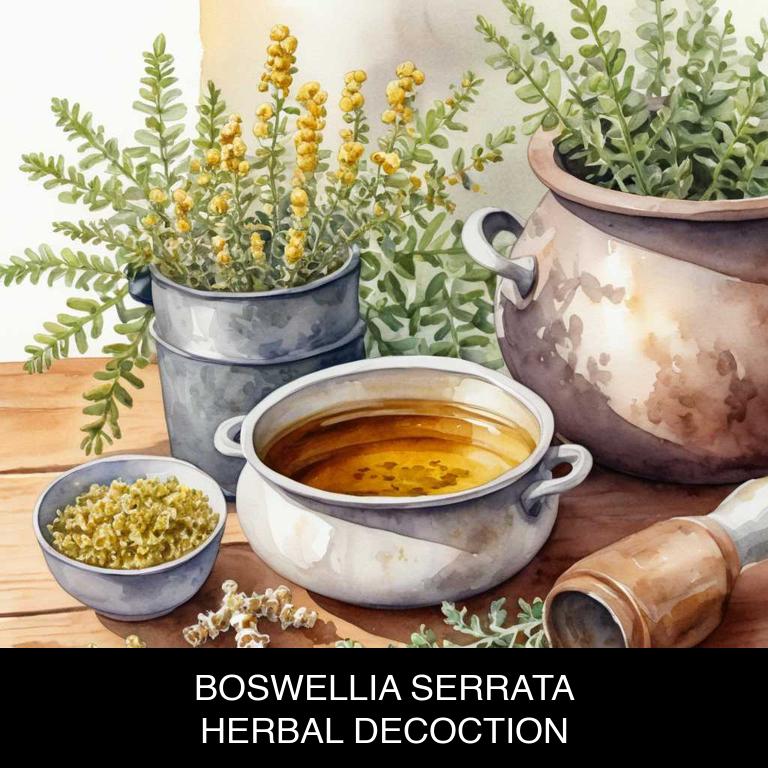
Medicinal Constituents
The list below shows the primary medicinal constituents in Boswellia serrata decoctions that help with leg pain.
- Acetyl-11-keto-β-boswellic acid: This triterpenoid acts as a potent anti-inflammatory agent, inhibiting the production of pro-inflammatory enzymes that contribute to leg pain.
- 3-acetyl-6α-acetoxy-β-boswellic acid: This triterpenoid has been shown to exhibit anti-inflammatory and analgesic properties, helping to reduce pain and inflammation in the legs.
- Α-acetoxy-β-boswellic acid: This triterpenoid has been found to possess anti-inflammatory and antioxidant properties, which may help alleviate pain and discomfort in the legs by reducing oxidative stress.
Parts Used
The list below shows the primary parts of frankincense used to make decoctions for leg pain.
- Roots: The roots of Boswellia serrata are primarily used to make decoctions for leg pain due to their high concentration of boswellic acids, which have anti-inflammatory properties.
- Barks: The barks of Boswellia serrata are used in decoctions to relieve leg pain because they contain compounds that help reduce inflammation and promote healing.
- Rhyzomes: The rhyzomes of Boswellia serrata are used to make decoctions for leg pain because they contain boswellic acids, which have anti-inflammatory and analgesic properties.
Quick Recipe
The following recipe gives a procedure to make a basic frankincense for leg pain.
- Weigh 1 to 3 grams of dried boswellia serrata resin and place it in a heat-resistant container.
- Add 200 milliliters of water to the container and gently heat it over low heat.
- Simmer the mixture for 5 to 10 minutes or until the water has been reduced slightly.
- Strain the decoction through a cheesecloth or a fine-mesh sieve into a separate container.
- Allow the decoction to cool before drinking 2 to 4 milliliters as needed.
4. Glycyrrhiza glabra
Licorice decoctions helps with leg pain because of its potent anti-inflammatory and antioxidant properties.
The plant's glycosides, such as glabridin and licoricidin, have been shown to reduce inflammation and relax muscle spasms, providing relief from aching and stiffness in the legs. Additionally, licorice root has been traditionally used to warm and nourish the body, increasing circulation and reducing fatigue.
As a result, herbal licorice decoctions can help alleviate leg pain associated with conditions such as arthritis, fibromyalgia, and poor circulation.

Medicinal Constituents
The list below shows the primary medicinal constituents in Glycyrrhiza glabra decoctions that help with leg pain.
- Glycyrrhizin: It helps with leg pain by inhibiting the activity of pro-inflammatory enzymes and reducing inflammation, which can contribute to pain relief.
- Liquiritigenin: It helps with leg pain by exhibiting analgesic and anti-inflammatory properties, which can help to reduce pain and inflammation in the legs.
- 18β-glycyrrhetinic acid: It helps with leg pain by inhibiting the production of pro-inflammatory mediators, such as prostaglandins, and reducing inflammation, which can contribute to pain relief.
Parts Used
The list below shows the primary parts of licorice used to make decoctions for leg pain.
- Roots: The roots of Glycyrrhiza glabra contain glycyrrhizin, a compound that helps to reduce inflammation and relieve pain.
- Barks: The barks of Glycyrrhiza glabra are used to make decoctions that are believed to warm the body, relieve pain, and improve circulation in the legs.
- Stems: The stems of Glycyrrhiza glabra are sometimes used to make decoctions that are thought to have anti-inflammatory properties and help alleviate pain and stiffness in the legs.
Quick Recipe
The following recipe gives a procedure to make a basic licorice for leg pain.
- Harvest 10-20 grams of dried roots of glycyrrhiza glabra from a trusted supplier.
- Clean the roots with cold water to remove any impurities or debris thoroughly.
- Chop the cleaned roots into small pieces to increase their surface area quickly.
- Combine the chopped roots with 1 liter of water in a saucepan and bring to a boil slowly.
- Simmer the mixture for 30-40 minutes then strain and discard the solids carefully.
5. Curcuma longa
Turmeric decoctions helps with leg pain because of its potent anti-inflammatory properties, which reduce swelling and ease discomfort.
The curcumin present in turmeric also blocks the production of prostaglandins, hormones that cause pain and inflammation. Additionally, turmeric's warming properties increase blood flow to the affected area, promoting healing and relaxation.
This natural remedy has been used for centuries to alleviate joint pain and stiffness, making it a popular alternative to over-the-counter medications.
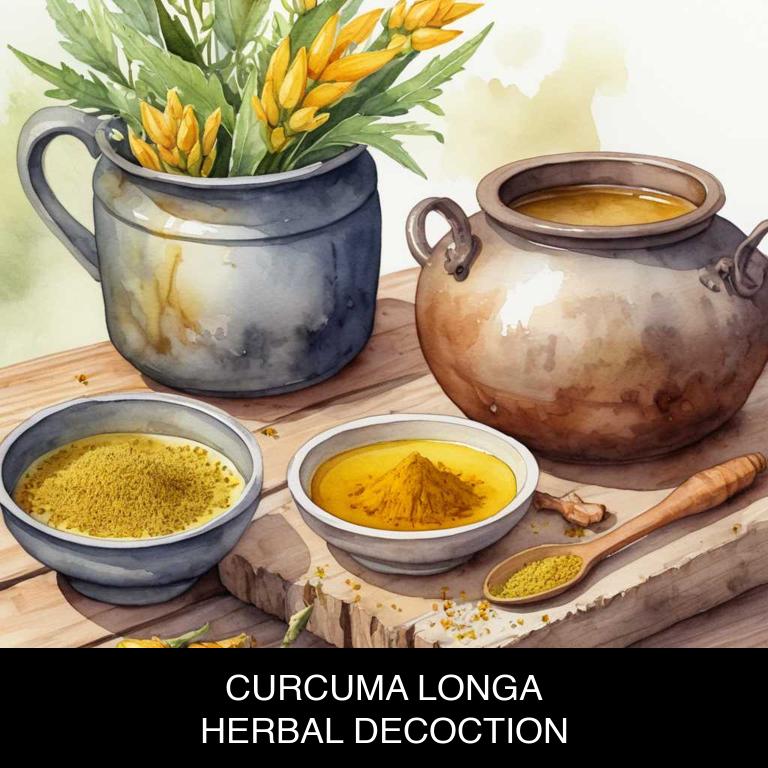
Medicinal Constituents
The list below shows the primary medicinal constituents in Curcuma longa decoctions that help with leg pain.
- Curcumin: Curcumin, a phenolic compound, helps with leg pain by reducing inflammation and oxidative stress, which are common underlying causes of pain in the legs.
- Demethoxycurcumin: DMC, another phenolic compound, helps with leg pain by inhibiting the production of pro-inflammatory enzymes and cytokines, thereby reducing pain and inflammation in the legs.
- Turmerone: Turmerone, a sesquiterpene, helps with leg pain by reducing inflammation and modulating the activity of certain neurotransmitters, such as substance P, which are involved in the transmission of pain signals.
Parts Used
The list below shows the primary parts of turmeric used to make decoctions for leg pain.
- Rhyzomes: Rhyzomes are the most used part of Curcuma longa due to their high concentration of curcumin, a potent anti-inflammatory compound that helps alleviate leg pain.
- Roots: Roots are another significant part used in decoctions as they contain curcumin and other bioactive compounds that reduce inflammation and ease leg pain.
- Barks: Barks are occasionally used in traditional medicine for leg pain relief, possibly due to their ability to reduce inflammation and relax muscles.
Quick Recipe
The following recipe gives a procedure to make a basic turmeric for leg pain.
- Choose 1-2 teaspoons of dried curcuma longa rhizome powder for the decoction.
- Boil 1 quart of water in a saucepan over high heat for 10 minutes.
- Add the curcuma longa powder to the boiling water and stir to combine for 1 minute.
- Reduce heat to low and simmer the mixture for 5-10 minutes to extract the active compounds.
- Strain the decoction through a cheesecloth or fine-mesh sieve into a clean container.
6. Camellia sinensis
Tea decoctions helps with leg pain because they contain natural compounds that work to reduce inflammation, relax muscles, and improve circulation.
The anti-inflammatory properties of herbs like ginger, turmeric, and willow bark can help alleviate chronic pain in the legs, such as arthritis or fibromyalgia.
Additionally, the warming and soothing effects of tea decoctions, often featuring ingredients like cinnamon, cloves, and cayenne pepper, can help to ease muscle cramps and spasms, providing relief from discomfort and stiffness.
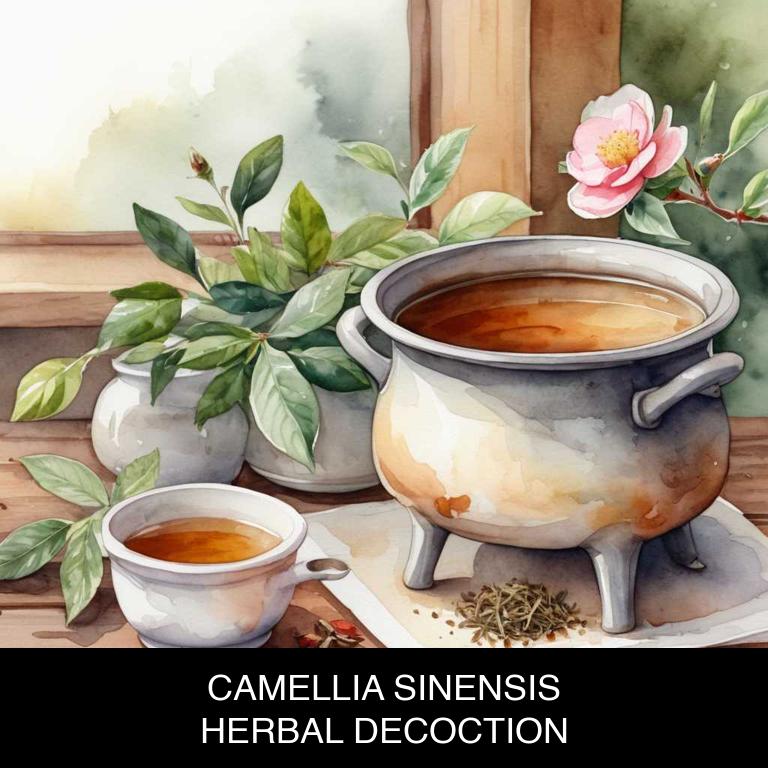
Medicinal Constituents
The list below shows the primary medicinal constituents in Camellia sinensis decoctions that help with leg pain.
- Theaflavins: These flavonoids have anti-inflammatory properties, which can help reduce pain and swelling in the legs.
- Catechins: EGCG has potent anti-inflammatory and antioxidant effects, which can help alleviate pain and inflammation in the legs.
- Quinic acid: This compound has anti-inflammatory and analgesic properties, which can help reduce pain and discomfort in the legs.
Parts Used
The list below shows the primary parts of tea used to make decoctions for leg pain.
- Roots: They are used due to their high concentration of caffeine and theobromine, which provide analgesic and anti-inflammatory properties.
- Leaves: They are used due to their high content of caffeine and theobromine, which help in reducing pain and inflammation associated with leg pain.
- Stems: They are used due to their high concentration of flavonoids and alkaloids that provide anti-inflammatory and analgesic properties.
Quick Recipe
The following recipe gives a procedure to make a basic tea for leg pain.
- Gather 5 grams of camellia sinensis leaves and 2 cups of water for decoction.
- Rinse the leaves with cold water and remove any stems or debris for cleaning.
- Combine the leaves and water in a saucepan and bring to a boil for preparation.
- Reduce heat and simmer for 5-7 minutes or until the liquid has reduced by half for steeping.
- Strain the decoction and discard the leaves for serving.
7. Piper nigrum
Black pepper decoctions helps with leg pain because of its potent anti-inflammatory properties, which effectively reduce swelling and ease discomfort in the legs.
The decoction's warming effect also improves circulation, which helps to reduce muscle stiffness and cramping. Additionally, black pepper contains piperine, a compound that has been shown to enhance the bioavailability of other pain-relieving compounds, amplifying its analgesic effects on leg pain.
As a result, herbal black pepper decoctions provide natural relief from chronic leg pain, making it an effective alternative therapy for individuals seeking a non-pharmacological solution.
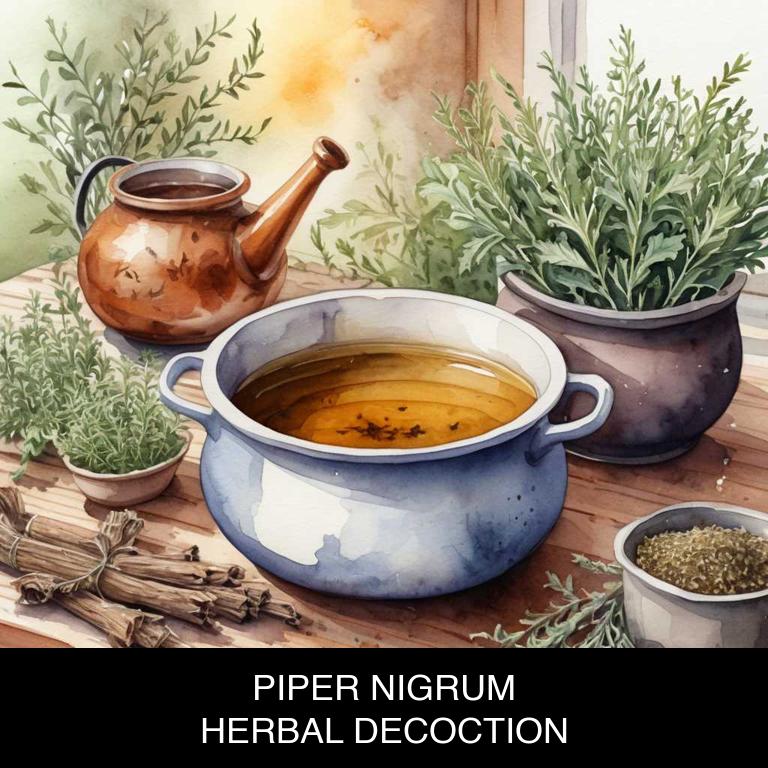
Medicinal Constituents
The list below shows the primary medicinal constituents in Piper nigrum decoctions that help with leg pain.
- Piperine: Piperine, a bioactive alkaloid found in Piper nigrum, has potent anti-inflammatory and analgesic properties, which help alleviate pain and inflammation associated with leg pain.
- Flavonoids: The flavonoids present in Piper nigrum decoctions, including kaempferol and quercetin, have antioxidant and anti-inflammatory properties that help reduce pain and inflammation in the legs.
- Terpinen-4-ol: Terpinen-4-ol, a monoterpenoid found in Piper nigrum, has analgesic and anti-inflammatory properties that help relieve pain and inflammation associated with leg pain.
Parts Used
The list below shows the primary parts of black pepper used to make decoctions for leg pain.
- Seeds: Piper nigrum seeds are commonly used in decoctions for leg pain due to their analgesic and anti-inflammatory properties, which help to reduce pain and inflammation.
- Buds: Piper nigrum buds are used in decoctions for leg pain as they contain compounds that help to relax muscles and reduce pain.
- Seeds: (second instance) Piper nigrum seeds are also used in decoctions for leg pain due to their ability to reduce inflammation and promote healing.
Quick Recipe
The following recipe gives a procedure to make a basic black pepper for leg pain.
- Harvest 5-7 grams of fresh p nigrum berries or 2-3 grams of dried berries.
- Clean the berries thoroughly to remove any dirt or debris present.
- Chop the berries into small pieces to release their active ingredients.
- Combine 1 liter of water with the chopped berries in a saucepan.
- Simmer the mixture for 10-15 minutes to release the flavors and oils.
8. Arnica montana
Mountain arnica decoctions helps with leg pain because of its anti-inflammatory properties, which effectively reduce swelling and ease discomfort.
The decoction's ability to penetrate deep into the muscles and connective tissue helps to alleviate tension and stiffness, providing relief from cramping, aching, and fatigue.
Additionally, mountain arnica has been shown to increase blood flow, which helps to nourish damaged tissues and promote healing, further contributing to its pain-relieving effects on the legs.
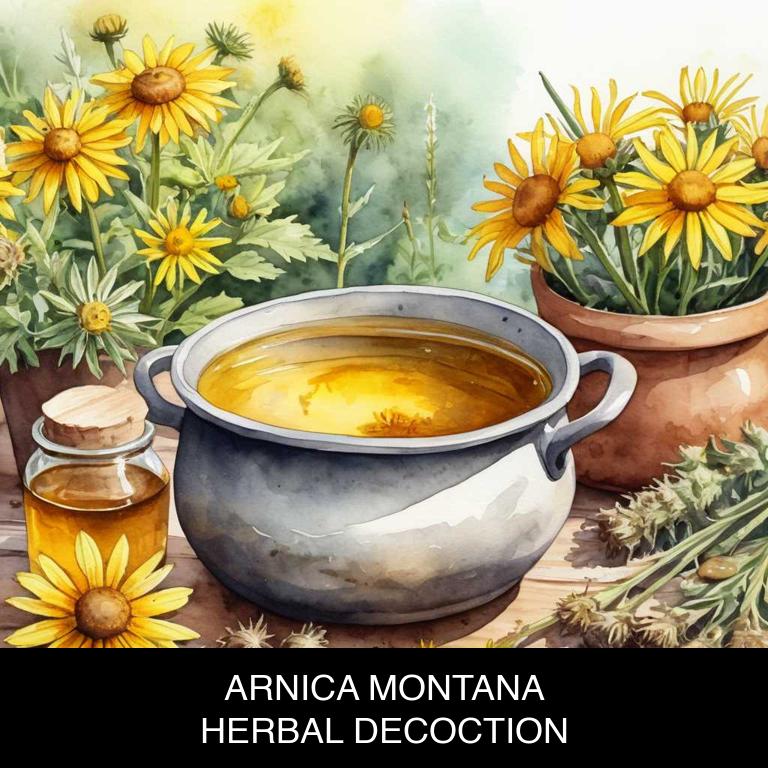
Medicinal Constituents
The list below shows the primary medicinal constituents in Arnica montana decoctions that help with leg pain.
- Thiophene derivatives: These compounds help reduce inflammation and pain in the legs by inhibiting the production of pro-inflammatory enzymes and mediators.
- Flavonoids: These antioxidants help alleviate leg pain by reducing oxidative stress, inflammation, and improving blood circulation to the affected areas.
- Alkamides: These compounds help reduce pain and inflammation in the legs by inhibiting the activity of pain-sensing nerve cells and reducing the production of pro-inflammatory cytokines.
Parts Used
The list below shows the primary parts of mountain arnica used to make decoctions for leg pain.
- Flowers: They are used due to their high concentration of sesquiterpene lactones, which possess anti-inflammatory and analgesic properties.
- Roots: They are used due to their high concentration of sesquiterpene lactones and phenolic compounds, which exhibit anti-inflammatory and pain-relieving effects.
- Leaves: They are used due to their content of flavonoids and phenolic compounds, which contribute to their anti-inflammatory and analgesic properties.
Quick Recipe
The following recipe gives a procedure to make a basic mountain arnica for leg pain.
- Harvest fresh arnica montana flowers and leaves in the early morning to ensure optimal potency.
- Clean the harvested plant material by gently rinsing it with cold water to remove any dirt or debris.
- Combine 2 tablespoons of arnica montana flowers and leaves with 1 quart of boiling water in a heat-resistant container.
- Steep the plant material in the boiling water for 5 to 10 minutes to allow for maximum extraction of active compounds.
- Strain the decoction through a cheesecloth or a fine-mesh sieve to remove the plant material and discard the solids.
9. Echinacea purpurea
Purple coneflower decoctions helps with leg pain because of its potent anti-inflammatory properties, which effectively reduce swelling and discomfort in the affected joints.
The decoction's flavonoids and saponins work synergistically to relieve inflammation and alleviate pain, providing much-needed relief for individuals suffering from conditions such as arthritis or sciatica.
Additionally, the decoction's antioxidant properties help protect the muscles and connective tissue from further damage, promoting faster healing and reduced pain.
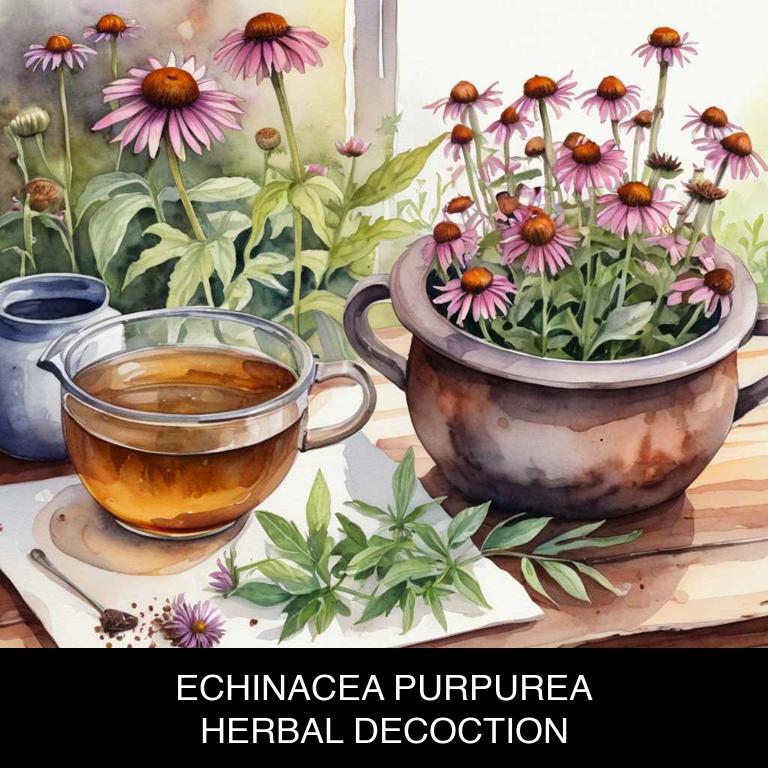
Medicinal Constituents
The list below shows the primary medicinal constituents in Echinacea purpurea decoctions that help with leg pain.
- Cichoric acid: This phenolic compound may help reduce inflammation and pain by inhibiting the production of pro-inflammatory enzymes, which could alleviate leg pain caused by inflammation.
- Isochinolinic alkaloids: These alkaloids may have anti-inflammatory and analgesic properties, contributing to pain relief and reducing inflammation in the affected leg area.
- Polyacetylenes: As a type of terpene, these compounds may exhibit anti-inflammatory and antioxidant activities, which could help alleviate leg pain by reducing inflammation and oxidative stress in the affected area.
Parts Used
The list below shows the primary parts of purple coneflower used to make decoctions for leg pain.
- Roots: The roots are used due to their high concentration of compounds with anti-inflammatory and pain-relieving properties.
- Leaves: The leaves are used because they contain chemicals that may help reduce pain and inflammation in the affected areas.
- Barks: The barks are used due to their content of compounds that may help to reduce pain and inflammation in the body.
Quick Recipe
The following recipe gives a procedure to make a basic purple coneflower for leg pain.
- Gather 20-30 grams of dried echinacea purpurea roots and flowers for the decoction.
- Boil 1 liter of water in a pot for 5-10 minutes to achieve boiling point.
- Add the echinacea purpurea roots and flowers to the boiling water for 10-15 minutes.
- Reduce heat to a simmer and continue to steep for an additional 10-15 minutes.
- Strain the decoction and discard the solids to obtain the final herbal infusion.
10. Calendula officinalis
Pot marigold decoctions helps with leg pain because it contains calendula, a natural anti-inflammatory agent that reduces swelling and alleviates discomfort.
The decoction's warmth and gentle stimulation also increase blood circulation, which can help relax tense muscles and relieve cramping.
Additionally, the calming properties of pot marigold may soothe irritated nerves, reducing sharp pains and numbness associated with conditions like sciatica or peripheral neuropathy, providing natural relief for aching legs.

Medicinal Constituents
The list below shows the primary medicinal constituents in Calendula officinalis decoctions that help with leg pain.
- Triterpenoids: These compounds help reduce inflammation in the legs, alleviating pain caused by conditions like arthritis.
- Phenolic acids: The anti-inflammatory and antioxidant properties of phenolic acids in Calendula help soothe and calm leg pain, promoting faster recovery from injuries or conditions like sciatica.
- Nascent flavonoids: The flavonoids present in Calendula, particularly nascent flavonoids, have potent anti-inflammatory and analgesic properties, helping to alleviate pain, reduce swelling, and promote healing in the legs.
Parts Used
The list below shows the primary parts of pot marigold used to make decoctions for leg pain.
- Flowers: They are rich in anti-inflammatory compounds, which help to reduce swelling and relieve pain in the legs.
- Leaves: The leaves contain flavonoids and other bioactive compounds that may help to reduce inflammation and ease leg pain.
- Roots: The roots of Calendula officinalis contain sesquiterpene lactones, which have anti-inflammatory and analgesic properties, making them effective in treating leg pain.
Quick Recipe
The following recipe gives a procedure to make a basic pot marigold for leg pain.
- Harvest fresh or dried calendula flowers in bulk depending on your desired batch size.
- Rinse the flowers under cold running water to remove dirt and debris gently.
- Combine 1 part flowers with 4 parts water in a saucepan to create a strong infusion.
- Bring the mixture to a boil then reduce heat and simmer for 10-15 minutes carefully.
- Strain the mixture through a cheesecloth or fine-mesh sieve into a clean container quickly.
What is the best combination of herbal decoctions to use for leg pain?
The best combination of herbal decoctions that help with leg pain is a blend of Willow Bark, Ginger, and Turmeric.
Willow Bark contains salicin, a natural anti-inflammatory that eases pain and reduces swelling. Ginger and Turmeric add anti-inflammatory properties and antioxidants, further soothing sore muscles and joints. This combination helps to reduce inflammation, relax muscles, and promote healing in the legs.
Drinking these decoctions regularly may provide long-term relief from chronic leg pain and promote overall well-being.
What ailments similar to leg pain are treated with herbal decoctions?
Ailments similar to leg pain that are treated with herbal decoctions are arthritis, fibromyalgia, and sciatica.
Herbal decoctions can help alleviate symptoms such as joint stiffness, muscle spasms, and chronic pain by promoting blood circulation, reducing inflammation, and relaxing muscles.
Decoctions made from herbs like turmeric, ginger, ashwagandha, and willow bark have been used for centuries to provide relief from these conditions.